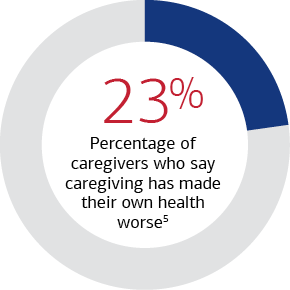1National Center for Health Statistics, “Yoga Among Adults Age 18 and Older: United States, 2022,” June 2024.
2National Center for Health Statistics, “Interactive Summary Health Statistics for Adults, 2023,” accessed July 2024.
3Centers for Medicare and Medicaid Services, “NHE Fact Sheet,” accessed July 2024.
4HealthView Services, “Addressing the Women’s Longevity Gap,” September 2020. Expressed in future dollars. Assumes the woman’s current age is 43, the man is 45, and their retirements will last 25 and 22 years, respectively. Premiums included are Medicare Parts B, D and Supplemental Insurance (Medigap) Part G.
5AARP and National Alliance for Caregiving, “Caregiving in the U.S.,” May 2020.
6BMC Health Services Research, “Impact of physical activity on healthcare costs: a systematic review,” June 2023.
Important Disclosures
Opinions are as of 08/05/2024 and are subject to change.
Investing involves risk, including the possible loss of principal. Past performance is no guarantee of future results. Asset allocation, diversification, and rebalancing do not ensure a profit or protect against loss in declining markets.
This information should not be construed as investment advice and is subject to change. It is provided for informational purposes only and is not intended to be either a specific offer by Bank of America, Merrill or any affiliate to sell or provide, or a specific invitation for a consumer to apply for, any particular retail financial product or service that may be available.
The Chief Investment Office (CIO) provides thought leadership on wealth management, investment strategy and global markets; portfolio management solutions; due diligence; and solutions oversight and data analytics. CIO viewpoints are developed for Bank of America Private Bank, a division of Bank of America, N.A., (“Bank of America”) and Merrill Lynch, Pierce, Fenner & Smith Incorporated (“MLPF&S” or “Merrill”), a registered broker-dealer, registered investment adviser, Member SIPC and a wholly owned subsidiary of Bank of America Corporation (“BofA Corp.”).
Investments have varying degrees of risk. Some of the risks involved with equity securities include the possibility that the value of the stocks may fluctuate in response to events specific to the companies or markets, as well as economic, political or social events in the U.S. or abroad.
Long-term care insurance coverage contains benefits, exclusions, limitations, eligibility requirements and specific terms and conditions under which the insurance coverage may be continued in force or discontinued. Not all insurance policies and types of coverage may be available in your state.
This material should be regarded as educational information on healthcare considerations and is not intended to provide specific healthcare advice. If you have questions regarding your particular healthcare situation, please contact your healthcare, legal and/or tax advisors.
The case studies presented are hypothetical and do not reflect specific strategies we may have developed for actual clients. They are for illustrative purposes only and intended to demonstrate the capabilities of Merrill and/or Bank of America. They are not intended to serve as investment advice since the availability and effectiveness of any strategy is dependent upon your individual facts and circumstances. Solutions presented are not appropriate for everyone. Results will vary, and no suggestion is made about how any specific solution or strategy performed in reality.







